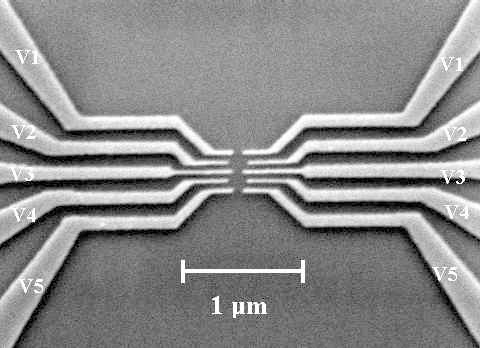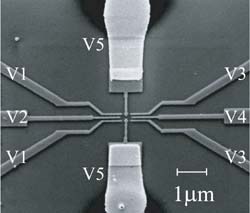
![]()
4 July 2100. The flick of a switch: a wall becomes a window becomes a door. Any chair becomes a hypercomputer, any rooftop a power- or waste-treatment plant. We scarcely notice; programmable matter pervades our homes, our workplaces, our vehicles and environments. There isn’t a city on Earth — or Mars, for that matter — that isn’t clothed in the stuff from rooftop to sub-basement. But though we rarely stop to consider it, the bones of these cities — their streets, their sewers, the hearts of their telecom networks — were laid out in a time when the properties of matter were dictated exclusively by mother nature.
- Wil McCarthy NATURE | VOL 407 | 5 OCTOBER 2000| www.nature.comFor the full text: http://www.wilmccarthy.com/nature.pdfThis is just one foreseeable future for material science and for the use of quantum dots in our everday lives. The power and versatility of quantum dots comes from their ability to be tuned to mimic the properties of almost any substance, and substances that cant even be imagined today.
What is a quantum dot?
A quantum dot is produced by confining electrons inside a semiconductor structure whose volume is smaller than the volume defined by the bohr radius for that semiconductor. (Bhor radius is the smallest possible radius of an electron orbit in the Bohr model of the atom, 5.29167 x 10-9 centimeters.) This confinement causes the electrons inside the dot to behave like standing waves just as they would if they were inside a natrual atom, but the big differance being that there is no nucleus so by adding or subtracting electrons the properties of the dot can be changed. The only properties that cannot be changed are the shape and mass of the dot.
How are quantum dots made?
One process for creating quantum dots is to create a quantum well. A quantum well is created by scattering a semiconductor with impurities, a very precise process known as doping, this then causes very intersting effects to take place within the semiconductor. If for instance silicon doped with electron donor atoms such as phosphorus it becomes an N, or negative-type, semiconductor, which contains one excess electron for every atom of dopant. These excess electrons have nowhere to bind, so they flow easily through the material, just as the more numerous excess electrons do inside a conductive metal. Doping with electron borrowers like aluminum produces a P, or positive material, which conducts "holes," or spaces where an electron isn't (http://www.wired.com/wired/archive/9.10/atoms.html) When a P is place next to a N it forms a P-N junction which acts as a electrical gate valve of sorts, only letting elctrons flow in one direction. When a P is placed on top and on bottom of a N, a sort of electron trap is formed attracting electrons into it and not letting go. When this quantum well is created small enoegh, as mentioned above, a quantum dot is formed.
(quantum mechanical waves captured in a circle of single atoms)
Another process is to grow semiconductor nanocrystals generally composed of cadmium sulfide (CdS), cadmium selenide (CdSe), or cadmium telluride (CdTe). These can be grown reliably into any shape desired and this final shape and size dictates many of the poperties of the dot. Quantum dots now being created out of nanocrystals are currently being used mainly in the biotech industry.
(Nanocrystal structures)
What are quantum dots currently being currntly used for?
Currently quantum dots have found a niche in the biotech industry. The quantum dots created in nanocrystals have the particular quality of emitting very narrow spectra of light that can be precisely controlled through the size and shape of the nanocrystal. This and advancements in being able to tag specific parts of a cell with a quantum dot, have allowed researches to be able to attach these light becons to specific cells at specific points and watch the growth, formation and chemical reactions of cells with new detail never before posible through use of chemical dyes. Quantum dots have even been attached to nuerons.
AUSTIN, Texas — By using the molecular-recognition capabilities of living cells, scientists have made selective electrical contacts to neurons. The cadmium sulfide contacts act as photodetectors, allowing researchers to communicate with the cells using precise wavelengths of light. By selectively coding peptides that coated quantum dots, University of Texas scientists precisely controlled the spacing of hundreds of quantum dots on the surface of the living neurons.... In this new biological application, attaching quantum dots directly to cells eliminates the need for external electrodes. The procedure is entirely non-invasive, similar to the use of fluorescent dyes to mark cells. And since molecular recognition is used, it is a "smart" technology that can pick precisely which capability will be controlled on each neuron to which a quantum dot is attached. Taken to the logical extreme, biologists could remotely control any neural function by activating select neurons.
- By R. Colin Johnson
EE Times
December 04, 2001The optical properties of quantum dots has also opened new doors for developing novel optical and optoelectronic devices, such as tunable lasers, optical amplifiers, and light emitting diodes, self optimizing solar cells as well as a replacement for LCDs. As lasers quantum dots offer higher power output for a smaller size laser and the ablity to tune the wavelength or color of the laser by adjusting the size of the quantum dot. This then could allow for major advancvements in microelectronics by making devices such as a CD player smaller, cheaper and higher densities of the CDs for more storage. But this pales in comparison with the ideas for using quantum dots to build ultra fast quantum computers.
In research that is part of an effort to make super powerful "quantum computers," Purdue University researchers have created quantum dots in this extremely fine circuitry, using a standard process known as electron beam lithography. A semiconducting material known as gallium arsenide was coated with a plastic. Then extremely fine lines were cut into the plastic coating using a beam of electrons. The lines were filled with a metal and the plastic dissolved, leaving behind metal lines that are like wires only about 50 nanometers wide. A nanometer – or billionth of a meter – is roughly 5-10 atoms wide. The quantum dots (shown in the center of the image) are puddles of about 20-40 electrons. Each dot measures only about 180 nanometers in diameter – about 5,000 of them could stretch across the width of a grain of sand. (Illustration by Albert Chang, Purdue University Department of Physics) http://news.uns.purdue.edu/html4ever/010917.Chang.quantum.html
The possibilites for quantum dots is mind-boggling. But one of the most astounding aspect of quantum dots is that they appear to not be limited by the number of electrons that they can have. Natrual atoms are only stable up unto 92 electrons and then the nucleus becomes unstable and the atom radioactive. Quantum dots, haveing no nucleus, theoretically can remain even when they have thousands of electrons. This could lead to the development of new artificial atoms with properties that we cannot even begin to imagine and will only come to fruition from the hard work of many differant scientists and general intrest from the public.
© Copyright 2004, Jason Turnquist. All Rights Reserved.







